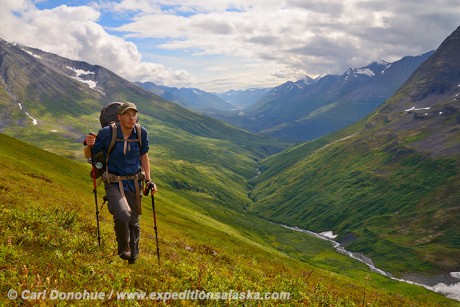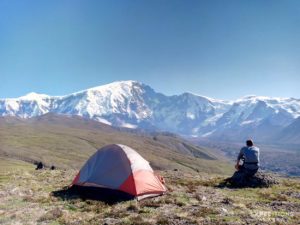
Hey Folks,
So one question I’m frequently asked about pertains to hiking poles, or trekking poles, and how important or useful they are for backpacking here in Alaska. In short, I’d suggest they’re more than useful, almost mandatory. Of course, few things in the mountains are ever so objective; the mountains are a subjective place, and so we shouldn’t look for objective answers like this. What’s right for me mightn’t be right for you, and what’s right on August 15 mightn’t be right on August 16 (or even 3 hours later on August 15), and so on. But as a general rule, I’d urge anyone coming to Alaska to backpack, and particularly someone on their first ever trip here, to count on using your hiking poles.
Jon, pictured above here, is a great hiker; in super shape, he’s athletic, well-balanced and a very good walker; safe to say he’s a much better hiker than the average backpacker. Much better. He cruised the Bremner Mines to Tebay Lakes route with virtually no trouble at all, and that’s a tough walk, by almost anyone’s metrics. Even Jon mentioned how useful and helpful the hiking poles were for him on this trip. This image, taken as we walked westward up Harry’s Gulch, shows one of the most strenuous parts of hiking in the mountains around here; Sidehilling. Walking along the edge of the hill/mountain is tough. It’s very tough. It mightn’t look like much here, but I guarantee you this stretch of the hike will kick your tail (and there’s plenty of walking like this on this particular route). Ask anyone who’s backpacked a lot in places like Wrangell-St. Elias National Park and they’ll tell you sidehilling, more than uphill or downhill, more than brush, more than rocks and boulders and moraine, and more than just about any other type of terrain you’ll likely encounter, is what separates the hikers from the stumblers.
You can see in this image the hillside is reasonably steep, and there’s no trail whatsoever to walk on. It’s tough, and you walk on this kind of terrain for a few hours and you’ll be feeling it. At the end of the day, you’ll be sore and tired. Dog tired. Carrying poles or at least one pole will help ease that weariness, and will help reduce the number of times you fall down. If I were Jon here, I’d have the pole on the uphill side (in his right hand) a little shorter than he’s carrying it, maybe 6-10 inches shorter, and I’d lengthen the one in my left hand. But Jon did fine, so it didn’t matter too much for him. For 99% of the rest of folks, it makes a difference to continually engage these little adjustments, and keep fine tuning the poles, etc, and tailoring them to your terrain.
Whether you want one pole (which is what I carry) or 2 poles, you’ll find the hiking MUCH easier with than without. River crossings become much more doable when you have a pole or 2 to help you, and they also make a helpful support pole for your tent/s if the wind really kicks up (which it can occasionally do). On the other hand, in thick brush, I’ll often shorten the pole all the way down to its shortest setting, and then strap it to the side of my pack for easier travel. It’s all about fitting the gear and the techniques to the terrain and the circumstance and your own experience or skill set.
Very few folks have come out with me over the last 15 years and done well without using trekking poles. VERY few. So count on bringing some for your trip. And walk carefully!
Cheers
Carl



